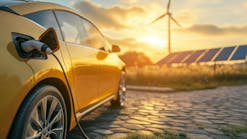According to the Advanced Energy Now 2019 Market Report, advanced transportation was the largest advanced energy segment worldwide in 2018 for the second year in a row, with an estimated US$494.8 billion in revenue, up 2% from 2017 and 8% the year before. Since 2011, the compound annual growth rate (CAGR) of advanced transportation globally was 6%. At the end of 2018, over five million plug-in electric vehicles (PEVs) were on the roads worldwide. PEV sales are poised to enter a period of strong growth, driven by lower battery prices, maturing plug-in hybrid and all-electric powertrain systems, and a proliferation of new models. By the end of 2027, Navigant Research expects there to be 10 times as many PEVs on the road. In the United States, PEV sales are surging as well, with overall advanced transportation revenue growing 34% year over year. Since 2011, U.S. advanced transportation revenue has grown at a CAGR of 15%.
Globally, clean diesel vehicles, both passenger cars and trucks of all sizes, still make up the bulk of the advanced transportation market, despite well-publicized issues, though evidence suggests that a massive shift toward PEVs is underway. At US$262 billion, clean diesel revenue accounted for well over half of advanced transportation revenue worldwide in 2018, despite dropping 12% from 2017. Hybrid electric vehicles (HEVs) continue to grow globally, with revenue from hybrid sales up 8%, to US$70 billion. But the growth story in advanced transportation is in PEVs, with revenue growing 49% globally, to US$78 billion, and 75%, to US$18 billion, in the United States.
Light duty PEV sales experienced another record year, with over two million vehicles sold worldwide, including 360,000 in the United States. As of June 2018, over 40 models of battery electric vehicles (BEVs) and plug-in hybrid electric vehicles (PHEVs) were on the market, with many more on the horizon in the coming years. Technology advances in battery packs continue to reduce the purchase price, making more affordable PEVs — such as Tesla Model 3, Chevrolet Bolt, and Nissan Leaf — a reality.
By 2021, over 25 new BEV and PHEV crossovers and SUV models are planned to be sent into production. Several, such as the Acura RDX and the Ford Escape, are existing models that will receive a BEV or PHEV model addition. Others, such as the BMW iNEXT, will be newly designed models. Tesla has stated it will add an all-electric pickup truck to its lineup of vehicles, although no release date has been announced. Electric vehicle (EV) truck startup, Rivian, has announced its first products and Ford has announced that it will electrify its best-selling vehicle, the F-150. Deployment of charging stations is the key element of the PEV market other than vehicles and there the United States is playing catch-up.
In the United States, PEV sales increased 32% between 2016 and 2017, and then leapt by 75% between 2017 and 2018, reaching US$18 billion in revenue. Over this time, PEV sales eclipsed those of HEVs, as revenue from hybrids has settled around US$9 billion annually, following a decline from its US$15 billion peak in 2013. PEV penetration has typically clustered around urban areas in states with incentives, though a shift may be coming as the number of models available in showrooms around the countries increases substantially. Many U.S. states with zero-emissions vehicle (ZEV) policies, such as California and New York, continue to boast the highest sales numbers, but states like Florida and Colorado are coming to the fore in PEVs. Indeed, Colorado now has an executive order requiring adoption of ZEVs, though not yet implemented.
Charging Infrastructure Paves the Road for EVs
In 2011, few predicted quite how soon EV adoption would occur. Few auto manufacturers were building battery-powered vehicles and most of these were hybrids that used a gasoline engine to charge batteries rather than the electricity grid. However, since 2011 the EV market has grown rapidly. Barriers to widespread adoption remain, among them so-called range anxiety — how far EVs can travel before refueling. Battery technology continues to improve, allowing for cars that are able to travel further on one charge. Another necessity for relieving range anxiety is the deployment of charging infrastructure, including dc fast charging.
Many parties are showing interest in EV charging infrastructure, including major oil companies. For utilities, EVs present the largest opportunity for load growth in a generation. Municipal, regional, and national governments are driving EV adoption and are incorporating EV charging networks in their long-term transportation plans. Equipment providers are focused on the charging market, including Siemens, Schneider Electric, and ABB, while private charging networks like EVgo are expanding rapidly. A significant degree of attention is now focused on fast charging corridors that enable long-range all-electric driving.
While growing at a rapid rate, the charging infrastructure market in the United States is just catching up to the rest of the world. Whereas worldwide revenue from charging infrastructure took a 250% leap in 2017, reaching US$3 billion, U.S. revenue increased just 25%, to US$228 million. Growth globally and in the United States largely tracked in 2018, was roughly at 25%.


